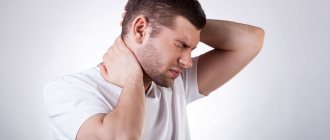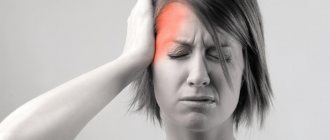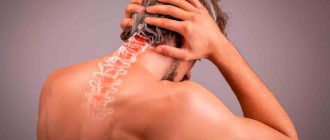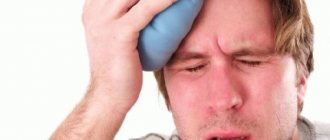Pain in the back of the head is a fairly common problem. And she has many reasons. Therefore, it is important to find their problems in order to feel relief. Let's find out together with a specialist how to do this.
Headaches in the back of the head can have several different causes. For example, it may only be muscle damage due to a minor injury, or it may be a secondary symptom of other pathologies. The type and location of pain can play a critical role in diagnosing the cause. If the pain is severe and repeated, be sure to consult a doctor.
Causes of pain in the back of the head in an adult
“Pain in the back of the head itself does not indicate the cause of this pain,” explains neurologist Elena Gaivoronskaya.
– The doctor assesses the frequency of pain, its intensity, duration, nature (pulsating, pressing, stabbing), associated symptoms. Only on the basis of all this data can a diagnosis be made. There are a number of reasons why headaches may occur predominantly in the back of the head.
headaches .
This is the most common cause of pain in the back of the head. Such pain can last from 30 minutes to 7 days. Such pain can be caused by severe stress, overwork, lack of sleep, malnutrition, poor posture or not drinking enough water.
Patients with this problem usually feel tension in the back or front of the head. The pain can range from dull to severe.
Migraine.
Another common type of headache that often appears in childhood and gets worse with age. Migraines are most common in women. Its symptoms include severe pain on one side of the head with nausea, vomiting and blurred vision. Patients are usually sensitive to light, noise, or smell. Physical activity may increase pain. It can last from several hours to several days.
Causes of migraines include emotional or physical stress, environmental and dietary changes. Sometimes medications (such as birth control pills) can also cause migraines.
Overuse of medications or recurring headaches.
These headaches can develop if a person takes too many painkillers. They are very strong and are often accompanied by nausea, anxiety, irritability, fatigue, difficulty concentrating, memory loss and even depression.
Occipital neuralgia.
A rare but severe headache that usually begins at the base of the neck and spreads to the back of the head and then behind the ears. Often occurs when the occipital nerves, which run up the back of the neck to the base of the skull, are damaged or irritated. The pain is accompanied by a burning or shooting sensation and persists on one side of the head, but often intensifies with movement of the neck. The patient is usually sensitive to light.
Possible causes include spinal injury, tumors, nerve damage caused by diabetes, swollen blood vessels, and rarely infection.
Headaches during physical activity.
They occur as a result of stressful activities and often occur after physical exercise. This pain resembles palpitations and can last from 5 minutes to 2 days.
Often occurs after heavy weight exercise or running. But sometimes they happen after sexual intercourse or pushing in the toilet.
Headache due to arthritis.
It appears in the back of the head and intensifies with movement. May be the result of arthritis of the first, second or third vertebra. Either it is associated with changes in the bone structure of the neck or inflammation of the blood vessels in the head.
In addition, the cause of a headache in the back of the head can be:
- osteochondrosis of the cervical spine;
- high blood pressure;
- increased intracranial pressure;
- stress;
- brain tumors;
- brain aneurysm;
- subarachnoid cerebral hemorrhage;
- cervical spine injuries and traumatic brain injuries;
- meningitis.
Causes of pathology
Numbness can occur for various reasons. It can be felt while working, sleeping, during the day or night. Considering the duration and frequency of numbness, you can determine what is causing it.
- long exposure to the cold;
- lying for a long time in a too uncomfortable position (this is often caused by the nature of the work);
- wearing bags with hard straps that put pressure on the skin;
- keeping your hand in an awkward position for a long time;
- scalene muscle syndrome, caused by compression of the branches of the brachial plexus and the artery under the collarbone;
- disturbances in the blood supply to the brain due to hypercholesterolemia and hypertension, which impede the flow of blood through the vessels;
- Raynaud's syndrome, expressed in circulatory disorders in small arteries located on the arm (its appearance is influenced by a hereditary factor);
- carpal tunnel disorder, caused by compression of the median nerve in the wrist area, which is caused by the same type of hand movements;
- metabolic disorders (in this case, only the hand goes numb);
- polyneuropathy resulting from deficiency of B vitamins;
- multiple sclerosis (in this case, paresis and numbness of other parts of the body are also observed);
- prolonged depression, severe stress;
- previous uterine fibroids, pneumonia and other diseases that provoke the occurrence of stagnation and adhesions that cause blood flow disturbances.
Modern methods of treatment
Treatment methods depend on the diagnosis.
Tension headaches.
They are usually treated with painkillers, massage and sometimes meditation. However, frequent tension headaches require medical supervision.
Migraine.
Treatment for this disease includes painkillers and rest in a darkened room. Doctors often recommend lifestyle changes, hormone therapy, and anti-migraine medications such as triptans to reduce the frequency and intensity of migraines.
Returning pain.
The best treatment for this type of pain is to stop taking painkillers. Yes, at first the headaches get worse, but they go away quickly.
In severe cases, you should consult a doctor - physical or behavioral therapy may be required to break the habit of using analgesics.
Occipital neuralgia.
It can be treated with heat compresses, rest, massage, physical therapy or painkillers. Severe pain may require oral muscle relaxants, nerve blocks, steroid injections, or local anesthesia. In rare cases, surgery is necessary to relieve pressure on the nerves or block pain impulses to that part of the body.
Pain during physical activity.
Taking painkillers before exercise can solve this problem. In addition, it is important to avoid stress, eat right and get enough sleep.
Treatment of headaches and hand numbness
Treatment is individualized and depends on the final diagnosis. Its goal is not only to eliminate unpleasant symptoms and pain, but also to get rid of their underlying cause. So, the doctor may prescribe:
- for stroke - a comprehensive rehabilitation program aimed at restoring nerve conduction in the affected areas, therapeutic exercises, exercises to improve memory and speech;
- for neck diseases - a set of exercises to perform at home, muscle relaxants, wearing a hard collar if necessary;
- for vascular diseases - a gentle diet, moderate physical activity, drugs to improve blood circulation in the brain;
- surgery - may be required to remove hernias and aneurysms; in some patients it is indicated for injuries.
At the Clinical Brain Institute, it is possible to receive treatment both on an outpatient basis and in an inpatient setting. Also in our center you can select an individual rehabilitation program after a stroke and undergo it under the supervision of doctors. It is important to understand that the effectiveness of treatment will depend not only on the correct prescriptions, but also on their implementation at home.
Popular questions and answers
We asked neurologists to answer questions related to headaches in the back of the head.
When can a headache in the back of your head be dangerous?
“Such symptoms,” says neurologist Olga Zincheva, “can include:
- concomitant increase in body temperature;
- weakness, awkwardness;
- numbness and tingling in the limbs or one limb;
- prolonged increase in pressure, difficult to reduce;
- severe headaches;
- headaches are accompanied by nausea and vomiting;
- double vision, impaired consciousness.
When to see a doctor for a headache in the back of the head?
“There are signs,” explains Olga Zincheva, “that require medical attention:
- you have a headache for the first time for no apparent reason;
- pain lasts several days;
- there are concomitant diseases.
“You need to go to the hospital immediately,” adds colleague Elena Gaivoronskaya, “if the headache occurs suddenly, it is very intense, there was no such pain before, or if the pain is accompanied by weakness in the limbs on one side of the body, a distortion of the face, speech disorder, or lack of coordination. If you have other alarming symptoms, you should consult a doctor as planned. You should also see a neurologist if you are taking too many pain medications or if your headaches are affecting your quality of life.
Osteochondrosis
This is a pathology of the cervical spine, in which there is a loss of functionality of the intervertebral discs and the transformation of cartilage into bone. Nerve fibers and blood vessels become pinched, causing problems with blood circulation and innervation of the nervous system.
Signs:
- My head is spinning.
- The back of my head goes numb.
- Pressure changes.
- Visual function deteriorates and a person may go blind.
- My head hurts.
Osteochondrosis responds well to therapy, which uses medications to stabilize the blood circulation process. Non-steroidal anti-inflammatory drugs, often doctors prescribe massage treatments.
Sometimes it is necessary to use a bandage to support the head and relieve tension from the muscle tissue. You need to use a woolen scarf to cover your neck.
You must first treat the skin with ointment. This eliminates swelling and pressure from nerve fibers and arteries, improves blood circulation.
Expert advice
If your hand begins to go numb, you should pay attention to your lifestyle and habits. Try to move as much as possible, climb the stairs on foot, without an elevator.
Be sure to do exercises in the morning. You can increase physical activity in other ways, for example, through dancing.
Provide your body with the microelements, vitamins and minerals necessary for its proper functioning. Eat more fruits and vegetables, and periodically take special multivitamin complexes.
Try to always remain calm, no matter the situation. By stopping worrying and getting nervous over trifles, you will soon feel better.
Causes of muscle spasms
Why is this happening? In fact, there can be many reasons. Most often, constant nervous strain, hypothermia or vitamin deficiency play a role. Only high-quality diagnostics can identify the specific cause. Often this trouble is caused by concomitant diseases of the musculoskeletal system, for example, osteochondrosis, which develops for the following reasons:
- Genetic predisposition.
- The presence of obesity of various degrees.
- Low activity.
- Poor metabolism.
- Sedentary work.
As mentioned above, muscle spasms in the head and neck are dangerous to health. First of all, the danger is manifested by the fact that regular spasms negatively affect blood circulation, that is, the required amount of oxygen does not reach the brain. This can lead to serious consequences, such as hypoxia. It is for this reason that experts do not recommend self-medication.
If you constantly ignore the manifestations of osteochondrosis, this is fraught with the development of additional pathological processes. Often people completely lose their ability to work; in more advanced cases, this can lead to disability. Before starting treatment, the patient is required to undergo a series of diagnostic procedures. If you begin to restore your health in time and take measures to eliminate spasms, you can return to your normal lifestyle.
Preventive measures
Hand numbness is much easier to prevent than to cure. For the purpose of prevention, you should follow certain procedures, monitor your diet, not worry about trifles, and adhere to a healthy, proper lifestyle.
In order to improve blood circulation in the arm and prevent the development of pathologies of the cervical spine, it is useful to perform the following exercises:
- Sit on a chair, grab your shoulders with your hands and perform circular movements with your joints ten to fifteen times with successive repetitions.
- Cross your fingers, place them on the back of your head, keeping your elbows at the same level, and then squeeze and spread your joints about fifteen times.
- Stand straight, spread your legs at shoulder level, place your hands on your hips. Perform body turns to the right and left ten times.
- As you inhale, raise your arms up, and as you exhale, gently lower them down.
- Stand straight and turn your head in both directions alternately, then tilt it towards each shoulder ten times.
- Rotate your head first counterclockwise, then in the opposite direction. It is advisable to perform this exercise while sitting, carefully monitoring your well-being.
Feeling of numbness in the neck - where to go
If you have a feeling of numbness in your neck, you need to make an appointment with a neurologist. This specialist has the necessary level of professional competence to identify the potential cause and eliminate it.
In most cases, numbness in the back of the neck is caused by osteochondrosis and its complications. In this situation, the best choice would be a vertebrologist. This doctor will be able to develop a course of restorative therapy, thanks to which you will be able to completely restore the lost health of the spinal column.
If numbness in the skin of the neck or muscles appears after a traumatic impact (fall, blow, participation in an accident, or simply emergency braking while driving in a car with the head thrown back), then you should immediately visit a traumatologist. This doctor will order an x-ray to rule out the possibility of a fracture or crack in the bone tissue of the spinal column. This is a very dangerous condition in which complete paralysis of the entire body can quickly develop. Therefore, you should not hesitate to seek medical help.
After contacting a neurologist or vertebrologist, an X-ray examination will also be prescribed. It will reveal indirect signs of the development of osteochondrosis (decrease in the height of the intervertebral spaces), deforming spondyloarthrosis (narrowing of the joint space), the development of osteophytes and disruption of the position of the vertebral bodies with their possible displacement. For further diagnosis, you will need to conduct an MRI examination, ultrasound examination of the vessels of the neck and brain. Consultation with an otolaryngologist, pulmonologist and cardiologist may be required.
If numbness of the neck muscle is caused by endocrine and vascular problems, such as diabetic angiopathy or atherosclerosis, then additional treatment will be required from an endocrinologist and vascular surgeon.











